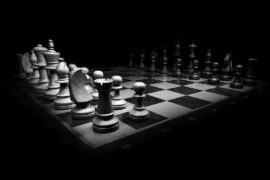What is grain of rice chess board?
Contents
- 1 What is grain of rice chess board?
- 2 The Legend of the Grain of Rice Chess Board
- 3 Understanding the Chess Board and Rice Grain
- 4 The Power of Exponential Growth
- 5 Mathematics Behind the Grain of Rice Chess Board
- 6 Practical Applications and Implications
- 7 Contemporary Examples and Challenges
- 8 Lessons Learned
- 9 Conclusion
In the realm of ancient legends and mathematical marvels lies a captivating tale that intertwines the simplicity of a grain of rice with the complexity of a chessboard. Picture this: a humble request from a wise sage to the ruler of a kingdom, asking for just one grain of rice to be placed on the first square of a chessboard, then doubling the amount on each subsequent square. Seems innocuous, doesn’t it? But as we delve deeper into the mathematics behind this seemingly simple request, we uncover the astonishing power of exponential growth.
The Legend of the Grain of Rice Chess Board
Legend has it that the concept of the grain of rice chess board originated in ancient India, where it was used as a lesson in humility and the consequences of underestimating the power of exponential growth. The story goes that a sage presented this challenge to a king, offering him the opportunity to fulfill any wish if he could complete the task. Little did the king realize the magnitude of the challenge he had accepted.

Understanding the Chess Board and Rice Grain
Before we unravel the mathematical intricacies of the grain of rice chess board, let’s familiarize ourselves with its components. A standard chessboard comprises 64 squares arranged in an 8×8 grid, alternating between light and dark colors. On the other hand, a grain of rice, seemingly insignificant in isolation, possesses a remarkable potential for growth when multiplied exponentially.
The Power of Exponential Growth
Exponential growth, a fundamental concept in mathematics, refers to a pattern of growth where the rate becomes increasingly rapid over time. In the context of the grain of rice chess board, this means that the number of rice grains on each square doubles with each subsequent square. To put it simply, the growth is not linear but exponential, leading to an astonishing outcome that defies intuition.
Mathematics Behind the Grain of Rice Chess Board
Now, let’s crunch some numbers. If we start with one grain of rice on the first square and double the amount for each subsequent square, by the time we reach the 64th square, the number of rice grains becomes astronomical. To put it into perspective, if we were to tally up the total number of rice grains on all 64 squares, it would exceed the current global rice production by several orders of magnitude.
Consider this: on the 64th square alone, there would be 263263 grains of rice, which is roughly 18 quintillion grains. This mind-boggling number highlights the astonishing power of exponential growth and serves as a stark reminder of the importance of understanding mathematical concepts beyond their surface level.

Practical Applications and Implications
While the grain of rice chess board may seem like a purely theoretical exercise, its implications extend far beyond the confines of a mathematical puzzle. Exponential growth plays a crucial role in various fields, from finance and economics to biology and technology. For instance, compound interest in finance and population growth in biology both follow exponential patterns, demonstrating the real-world relevance of this concept.
Furthermore, the grain of rice chess board serves as a poignant metaphor for the finite resources of our planet and the unsustainable nature of exponential growth. As we grapple with issues such as overpopulation, resource depletion, and environmental degradation, understanding the mathematics behind exponential growth becomes increasingly imperative.
Contemporary Examples and Challenges
In today’s interconnected world, the grain of rice chess board concept finds new applications and challenges. From the exponential growth of data in the age of information technology to the proliferation of social media networks, we are constantly confronted with the consequences of exponential growth.
However, this exponential growth also presents opportunities for innovation and progress. For instance, advancements in artificial intelligence and machine learning leverage the power of exponential growth to drive transformative changes in various industries, from healthcare to transportation.
Lessons Learned
As we conclude our exploration of the grain of rice chess board, let us reflect on the lessons it imparts. Beyond its mathematical complexities, this ancient puzzle teaches us humility in the face of exponential growth and the importance of foresight in addressing the challenges of our rapidly evolving world.
The concept of the grain of rice chessboard, often referred to as the “rice and chessboard problem” or the “legend of the chessboard”, is a classic illustration of exponential growth. Here are some lessons we can learn from this concept:
- Exponential Growth: The main lesson is the astounding power of exponential growth. On the chessboard, each square doubles the amount of rice given compared to the previous square. This seemingly innocuous progression leads to an astronomical amount of rice by the end.
- Understanding Compounding Effects: The story highlights the compounding effect of consistent growth over time. Initially, the growth may seem slow or insignificant, but over time it becomes overwhelming. This is a crucial concept in various fields such as finance, population growth, and technology.
- Importance of Long-Term Perspective: The story emphasizes the importance of thinking long-term and considering the consequences of actions over extended periods. Small decisions made consistently can have profound effects over time.
- Resource Management: The concept underscores the importance of efficient resource management. In the story, the emperor’s promise to double the rice on each square of the chessboard quickly leads to a situation where an impossible amount of rice is required, highlighting the importance of considering resource constraints and planning accordingly.
- Risk Assessment and Planning: It emphasizes the need for careful risk assessment and planning. In the story, the emperor’s promise was made without considering the practical implications. It’s essential to assess the potential consequences of commitments and promises before making them.
- Limits of Growth: The story also illustrates the limits of exponential growth. While the growth may appear limitless initially, practical constraints such as available resources eventually impose limits on growth.
- Unintended Consequences: The story demonstrates how seemingly innocuous decisions or promises can have unintended and significant consequences. It serves as a reminder to carefully consider the potential ramifications of actions and decisions.
Overall, the grain of rice chessboard concept serves as a powerful metaphor for understanding exponential growth and its implications across various aspects of life, from personal finance to business strategy to environmental sustainability.
Conclusion
In the grand tapestry of mathematical marvels, the grain of rice chess board stands as a testament to the astonishing power of exponential growth. From its humble origins in ancient legends to its contemporary relevance in a world shaped by technology and innovation, this simple yet profound concept continues to captivate and inspire us.
As we marvel at the boundless potential of exponential growth, let us also heed the lessons it imparts. By embracing curiosity, fostering collaboration, and embracing the inherent beauty of mathematics, we can unlock new horizons of knowledge and understanding, enriching our lives and shaping a brighter future for generations to come.

In the end, the grain of rice chess board reminds us that even the smallest grain of rice holds within it the seeds of exponential growth and infinite possibility. It is up to us to nurture these seeds and cultivate a world where curiosity flourishes, knowledge thrives, and exponential growth becomes a force for good.




